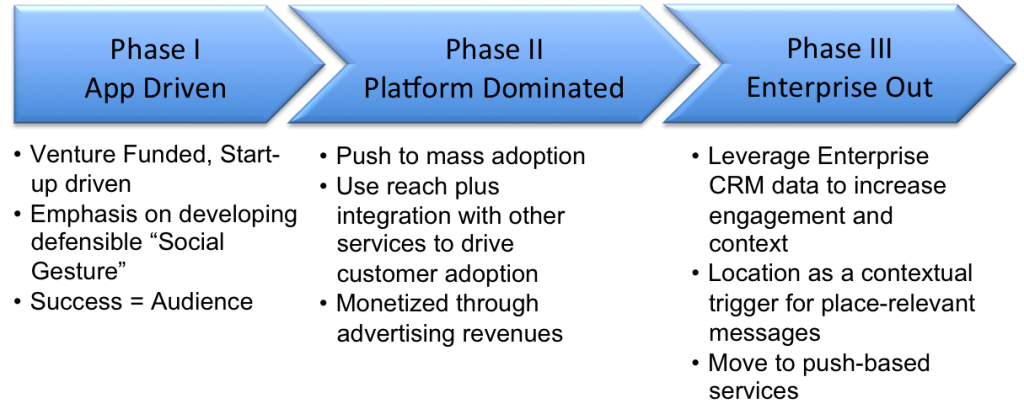 In the previous post, I speculated that, despite the current infatuation with Pull-style location based apps, ultimately Push-based apps will have more appeal to enterprises wanting to connect with their customer base. My premise is that they won’t have a choice. While they may experiment with games, check-ins or what ever comes next, ultimately they will want to leverage their rich CRM data and they will want to own the customer connection. Working through a third party app won’t give them that. Developing their own app won’t get mind share. So they will look at ways to talk directly to the customer at the time and place of their choosing. And that will be through push.
In the previous post, I speculated that, despite the current infatuation with Pull-style location based apps, ultimately Push-based apps will have more appeal to enterprises wanting to connect with their customer base. My premise is that they won’t have a choice. While they may experiment with games, check-ins or what ever comes next, ultimately they will want to leverage their rich CRM data and they will want to own the customer connection. Working through a third party app won’t give them that. Developing their own app won’t get mind share. So they will look at ways to talk directly to the customer at the time and place of their choosing. And that will be through push.
I’d further speculate that we will see three phases:
In the first, independent application start-ups will get funded and go at it, trying to grab attention and audience though some novel (or not so novel) social gesture. That’s been happening for two years.
In the second phase, the large Internet platforms will acquire or more likely clone the successful social gestures and roll them out to their massive audiences. We are seeing this now. Facebook and Google are launching places, check-ins and deals already. They can be late to the game and still win. Ultimately, anyone with less than 100M users will fade to the back pages of your smartphone.
In the third phase, enterprises will start to optimize location based offers based on their strengths. Their customer knowledge will allow them to make offers relevant and valuable; two criteria that consumers have indicated make the difference between something you want to get and spam. And they will have the advantage of an audience that has been conditioned to location based offers.
 Good news/Bad News
Good news/Bad News
First the bad news: If correct, this is bad news for the Pull-type apps. A smaller percentage of the total local advertising spend will come their way. Fewer will survive as those dollars flow to the bigger apps that get enough mindshare to warrant a place on the first screen of your phone. Brands will experiment with innovators who try new things. But as new engagement models are accepted, the bigger platforms (Google, Facebook, Apple, etc.) will clone them and extend them to their bigger audiences. And ad dollars will follow audience.
It is good news for a range of companies that innovate on push type services. There are technical challenges to make this work (location management, privacy, advanced geo-fencing, location based triggering). Companies that develop those capabilities will be in demand as the market grows.
Location based analytics will also be in demand. For push to work, context will be critical. Location is just a part of that context but an important one. Companies that help advertisers and brands understand location context will be interesting players. This is currently a nascent field; I expect significant innovation here.
It is also good news for the major enterprise software providers (SAP, Oracle, etc.). These companies have the opportunity to leverage their existing positions as CRM Software/service providers to the biggest enterprises by going mobile and local. These companies can partner with or acquire capabilities specifically targeted to this task, without the shifting landscapes of the location based app world.
When?
Warning: A critical self-assessment of my past success in predicting the future tells me that I am pretty good on trends and less good on timing. I tend to think things will happen sooner than they do. So it is with great caution that I submit that this will evolve fairly quickly, like in the next two years.
For many years the promise of Location Based Services was held up by the lack of the basic infrastructure: location determination (aka GPS and other technologies), accessible data plans, etc. These are mostly resolved. There are some hard things to be done for push technology and analytics but this is coming along fast.
The interest in location based ad models, driven by the Active user apps is getting attention from advertisers. As they experiment, they will find out what they like, and what they don’t. Starting that process has taken a long time, but it can move pretty fast from now on.
Finally the CRM systems are in place, the data is there and the communities exist. They just need to be extended.
All together, I think we are two years out from some very interesting push based services executed on a large scale, allowing major brands to connect directly to their customers.
